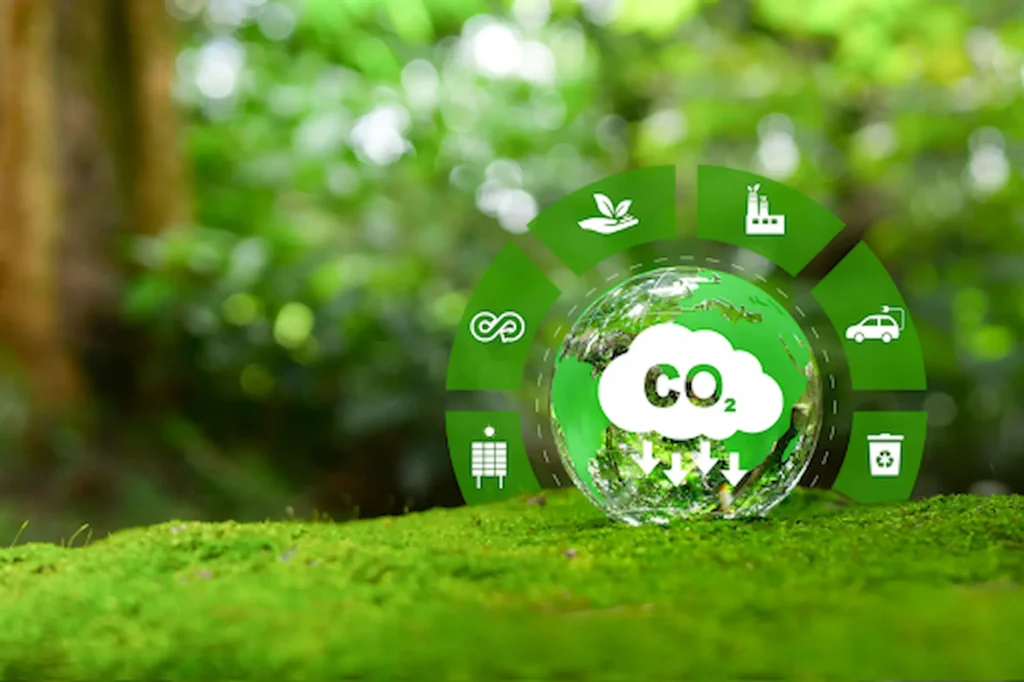Reduce carbon footprint is one of the most impactful actions you can take for a healthier planet. In the USA, individuals contribute significantly to carbon emissions through daily activities like transportation, energy use, and consumption habits. By making mindful changes, you can lower your carbon footprint while improving your lifestyle and even saving money.
Understanding Carbon Footprint and Why It Matters
Your carbon footprint refers to the total greenhouse gases produced directly or indirectly by your activities. These emissions contribute to climate change, which impacts ecosystems, weather patterns, and biodiversity. At Green Zone Hub’s Climate Education section, you can learn how personal choices connect to global environmental health. By understanding the source of emissions, you can start making changes that truly matter.

Make the Switch to Renewable Energy
Switching to renewable energy sources like solar or wind power can drastically cut your carbon output. This transition reduces dependence on fossil fuels, a major contributor to climate change. In the USA, many households are now choosing green energy plans. If you want to know more about renewable energy options and their benefits, visit our Renewable Energy Awareness page for in-depth insights.

Embrace Sustainable Living Practices
Living sustainably doesn’t mean giving up comfort—it means making smarter choices. This can include reducing waste, reusing items, and choosing eco-friendly products. Our Sustainable Living category provides practical advice that works for both individuals and families. Every small change, from adjusting your diet to being mindful of water usage, adds up over time.

Grow Your Own Food in Urban Spaces
Urban gardening is an excellent way to lower your carbon footprint. By growing vegetables, fruits, or herbs at home, you reduce transportation emissions linked to store-bought produce. Plus, it’s a great way to enjoy fresh, organic food. If you want to start your own green corner, check out our Urban Gardening guides for tips suited to American homes and apartments.

Protect Wildlife and Support Biodiversity
A healthy environment depends on thriving biodiversity. Conserving natural habitats and supporting wildlife-friendly practices can reduce carbon emissions caused by habitat destruction. Our Wildlife Conservation and Biodiversity section shares ways you can help protect nature, even from your own backyard.
Take Action Today
Every step you take to reduce your carbon footprint makes a difference. Whether it’s changing your energy source, adopting a plant-based diet, or supporting conservation projects, the impact grows when communities work together. If you’re ready to start your journey toward a greener future, you can Get in Touch with us today for personalized guidance and solutions.
Why Choose Green Zone Hub
At Green Zone Hub, we are committed to guiding individuals, families, and businesses toward environmentally friendly practices that actually work. Our resources cover climate education, renewable energy, sustainable living, urban gardening, and biodiversity protection. Whether you are new to sustainability or ready to take advanced steps, we provide practical, location-relevant advice tailored for the USA. With our expertise, you can start reducing your carbon footprint in ways that fit your lifestyle.
Conclusion
Reducing your carbon footprint is not just about protecting the planet—it’s about creating a healthier, more sustainable lifestyle for yourself and your community. Small actions like switching to renewable energy, practicing sustainable living, and growing your own food can lead to meaningful change. In the USA, where energy consumption and emissions are high, taking responsibility for our impact is essential. Every conscious choice you make is a step toward a cleaner, greener future.
Frequently Asked Questions
Q: What is the easiest way to start reducing my carbon footprint?
A: Begin with small changes, like using energy-efficient appliances, reducing waste, and switching to renewable energy sources. These actions can significantly cut emissions.
Q: Does reducing my carbon footprint really make a difference?
A: Yes, individual efforts add up. When millions of people make sustainable choices, the collective impact can slow climate change and protect biodiversity.
Q: How can I reduce my carbon footprint if I live in a city?
A: Urban gardening, public transportation, energy-efficient living, and supporting eco-friendly businesses are great ways to reduce emissions in urban areas.
Q: Can businesses also reduce their carbon footprint?
A: Absolutely. Companies can switch to renewable energy, adopt sustainable supply chains, and encourage remote work to lower emissions.
Q: Where can I find more tips on sustainable living?
A: Visit our Sustainable Living section for easy, practical advice tailored to the USA.
Q: How can I measure my carbon footprint?
A: You can use free online carbon footprint calculators. They consider your energy use, travel habits, and lifestyle choices to estimate your total emissions.
Q: Does eating less meat really reduce my carbon footprint?
A: Yes. Meat production has a high carbon cost, especially beef and lamb. Reducing meat consumption or choosing plant-based meals can lower emissions significantly.
Q: Is renewable energy expensive in the USA?
A: The cost of renewable energy has dropped in recent years. Many states also offer incentives, rebates, and tax credits to make it more affordable.
Q: Can planting trees help offset my carbon footprint?
A: Absolutely. Trees absorb carbon dioxide from the atmosphere, helping to offset emissions and improve air quality.
Q: How does public transportation reduce carbon footprint?
A: Buses, trains, and shared transport produce fewer emissions per passenger compared to individual cars, making them a greener choice.
